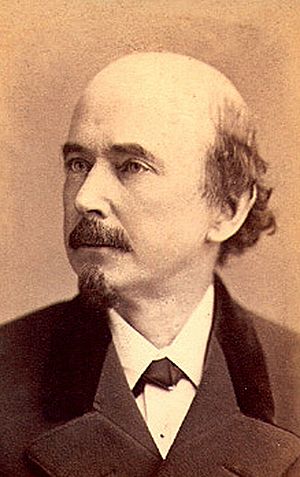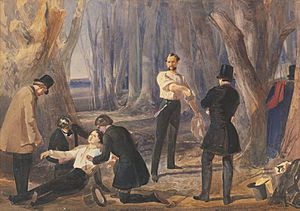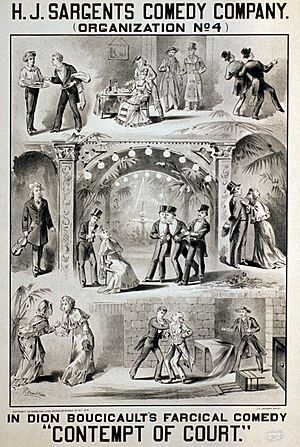Dion Boucicault facts for kids
Quick facts for kids
Dion Boucicault
|
|
|---|---|

Dion Boucicault, c. 1862
|
|
| Born | Dionysius Lardner Boursiquot 26 December 1820 Dublin, Ireland |
| Died | 18 September 1890 (aged 69) New York City, United States |
| Resting place | Mount Hope Cemetery, Hastings-on-Hudson, New York, United States |
| Occupation | Playwright, actor |
| Language | English |
| Nationality | British subject, Anglo-Irish |
| Notable works | London Assurance, The Octoroon, The Colleen Bawn, The Shaughraun |
| Spouse | Anne Guiot (m.1845–d.1845) Agnes Kelly Robertson (m.1853–d.1916; marriage dissolved 1888) Josephine Louise Thorndyke (m.1885–1890; his death) (bigamously) |
| Children | Dion William Boucicault (1855–76) Eva Boucicault (1857–1909) Dionysius George Boucicault Jr. (1859–1929) Patrice Boucicault (1862 – 1890) Nina Boucicault (1867–1950) Aubrey Boucicault (1868–1913) |
| Relatives | Dionysius Lardner (putative father) Anne Darley (mother) George Darley (uncle) |
| Signature | |
Dionysius Lardner "Dion" Boucicault (born Boursiquot; December 26, 1820 – September 18, 1890) was a famous Irish actor and playwright. He was especially known for his exciting plays called melodramas. These plays often had lots of drama, music, and clear heroes and villains. By the late 1800s, Boucicault was one of the most successful people in English-speaking theatre. He was an actor, a playwright, and a manager of theatres.
Even though he was called "the most important English dramatist of the 19th century" when he died, Dion Boucicault and his second wife, Agnes Robertson Boucicault, became American citizens in 1873.
Contents
About Dion Boucicault
Early Life and Education
Dion Boucicault was born in Dublin, Ireland, on December 26, 1820. His birth name was Dionysius Lardner Boursiquot. His mother was Anne Maria Laura Beresford. She was the sister of a poet and mathematician named George Darley. The Darley family was a well-known Anglo-Irish family in Dublin.
Dion's mother moved to London in 1828, and Dion went with her. From then on, he went to different schools around London. He attended a private school in Hampstead and later University College School. While at school, he became friends with Charles Kenney. He also went to Wyke House, a school in Brentford. There, he acted in a school play called Pizarro. He also wrote his very first play, The Old Guard, which was performed later.
In his late teenage years, Boucicault worked as a clerk at a brewery in Dublin. He later moved back to London in 1840 to study at the Dean Street Academy.
A Talented Playwright and Actor
Boucicault soon started acting professionally, using the stage name Lee Morton. He performed with famous actors like William Charles Macready. He also began writing plays, sometimes acting in them too.
His first play, A Legend of the Devil's Dyke, opened in Brighton in 1838. A few years later, he had a huge success with his play London Assurance. It was first performed in 1841 and featured many well-known actors of the time.
After this, Boucicault quickly wrote many other successful plays. Some of these included Old Heads and Young Hearts (1844) and The School for Scheming (1847). He also had big hits with The Corsican Brothers (1852) and Louis XI (1855). These were adaptations of French plays.
In 1852, Boucicault played the main role in his play The Vampire. He played a vampire named Sir Alan Raby. People praised his acting, calling it "dreadful and weird" and full of "immortal genius." In 1854, he wrote and starred in Andy Blake; or, The Irish Diamond.
From 1854 to 1860, Boucicault lived in the United States. He was very popular there and toured with his actress wife, Agnes Robertson. He wrote many successful plays during this time, often acting in them himself. One popular play was Jessie Brown; or, The Relief of Lucknow in 1858.
Theatre Manager and Producer
Around 1855, Boucicault started working as a business manager and partner in New York with William Stuart. They managed Wallack's Theatre for a short time.
In late 1855, Boucicault took over the Varieties Theatre in New Orleans. He renamed it the Gaiety Theatre. He opened it on December 1 with his play Used Up. His wife, Agnes Robertson, also performed there.
In 1859, Boucicault and William Stuart became partners again. They took over Burton's New Theatre on Broadway. After making many changes, Boucicault renamed it the Winter Garden Theatre. On December 5, 1859, he premiered his new and very popular play, The Octoroon. This play was important because it was one of the first serious plays about the Black American population. Boucicault also starred in it.
Boucicault later returned to England. There, he created a play called The Colleen Bawn for the Adelphi Theatre. This play was based on a novel. It became one of the most successful plays of its time and was performed all over the United Kingdom and the United States. Even though it earned him a lot of money, he lost it while managing different theatres in London.
After returning to England, Boucicault helped the American comedian Joseph Jefferson rework a play. It was Jefferson's adaptation of Washington Irving's Rip van Winkle. Their play opened in London in 1865 and on Broadway in 1866.
Boucicault had another big success in 1864 with Arrah-na-Pogue. He played a character from County Wicklow, Ireland. This role, and his amazing performance as "Conn" in his play The Shaughraun (first performed in New York in 1874), made him known as the best "Stage Irishman" of his time. A "Stage Irishman" was a type of character in plays that showed Irish people in a certain way.
In 1875, Boucicault moved back to New York City. He continued to write plays, like the melodrama Contempt of Court in 1879. He also visited London and other places. His last performance in London was in his play, The Jilt, in 1885.
Boucicault was a very good actor, especially in sad or emotional roles. He was so good at playing these characters that people called him "Little Man Dion." Many of his plays were adaptations of other works, but he was very clever in how he put them together. His plays were very popular.
Family Life
Dion Boucicault was married three times. His first marriage was to Anne Guiot in 1845. She passed away later that year. In 1853, he married Agnes Kelly Robertson in New York. Agnes was an actress and a very talented performer.
Dion and Agnes had six children together:
- Dion William Boucicault (1855–1876)
- Eva Boucicault (1857–1909)
- Dion Jr. (1859–1929)
- Patrice Boucicault (1862–1890)
- Nina Boucicault (1867–1950)
- Aubrey (1868–1913)
Three of their children, Dion Jr., Nina, and Aubrey, became famous actors themselves. Patrice became a singer. His granddaughter, Rene Boucicault (1898–1935), who was Aubrey's daughter, also became an actress and appeared in silent films.
In 1885, Boucicault toured Australia. During this trip, he married Josephine Louise Thorndyke (born around 1864) in Sydney. She was a young actress.
Dion Boucicault's last play, A Tale of a Coat, opened in New York in August 1890. It closed a month later. He passed away in 1890 in New York City and was buried in Mount Hope Cemetery.
Selected Works
Here are some of Dion Boucicault's most famous plays:
- London Assurance (1841)
- Old Heads and Young Hearts (1844)
- The Corsican Brothers (1852)
- The Vampire (1852)
- The Poor of New York (1857)
- The Octoroon or Life in Louisiana (1859)
- The Colleen Bawn or The Brides of Garryowen (1860)
- Arrah-na-Pogue (1864)
- Rip van Winkle or The Sleep of Twenty Years (1865)
- After Dark: A Tale of London Life (1868)
- The Shaughraun (1874)
- The Jilt (1885)
See also
 In Spanish: Dion Boucicault para niños
In Spanish: Dion Boucicault para niños
- Dionysius Lardner (likely Boucicault's father)
- See a man about a dog




